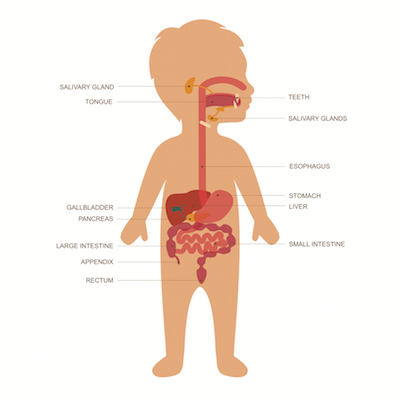How motility studies offer new hope for kids with gastrointestinal disorders
When it comes to our bodies, there are a few constant rhythms that must take place in order to maintain life. Our hearts must beat, our lungs must breathe in oxygen and expel carbon dioxide, and oxygen-rich blood must be carried to every tissue in the body. There’s another rhythm that must take place, too, for the body to sustain itself- nutrition must be taken in and waste must be expelled. This doesn’t happen every minute of our lives like heartbeats and breathing, but the repeated cycle of taking nutrition into the body and expelling waste is a basic principle that every body must accomplish to stay alive.
 Our bodies fulfill this need to receive nutritive substances, keeping what it needs and expelling the rest, through several organs known collectively as the digestive tract. This means that the mouth, esophagus, stomach, small intestine, large intestine, rectum and anus all perform different functions along the way in which food is transformed and used within the body.
Our bodies fulfill this need to receive nutritive substances, keeping what it needs and expelling the rest, through several organs known collectively as the digestive tract. This means that the mouth, esophagus, stomach, small intestine, large intestine, rectum and anus all perform different functions along the way in which food is transformed and used within the body.
What happens when something along the digestive tract isn’t working properly?
When an area of the digestive tract has trouble, the entire system suffers. Think of it as a roller coaster that has trouble on the tracks. There’s only one pathway for a roller coaster to travel, so trouble in one area affects the entire system. When a part of a person’s digestive tract has trouble, it can impact the entire mechanism their body uses to take in, digest and expel food. What’s harder is that in the digestive system, unlike the roller coaster, the trouble spots aren’t visible to the naked eye, so it’s sometimes a challenge to determine which trouble spots need to be addressed.
That’s why motility studies can change a child’s life who has a digestive disorder.
When children come to see a pediatric gastroenterologist, it is generally because they are experiencing consequences of some area of their digestive tract that isn’t working properly. They may have constipation or diarrhea, trouble swallowing, pain or vomiting, inability to tolerate certain foods or other problems that bring them to the doctor. One of the main responsibilities of the pediatric gastroenterologist is to determine which area of the digestive tract isn’t working properly, and that conclusion will then determine what types of treatment will benefit the child.
 Many times a child can be diagnosed based on the signs and symptoms of their current illness along with their history and physical exam. Physicians may also use various imaging techniques to visualize various aspects of the child’s digestive tract to detect physical abnormalities that could explain their symptoms. Again, unlike the roller coaster, we can’t easily see the internal organs so these images allow doctors to look at the organs to see if they can identify any physical problems.
Many times a child can be diagnosed based on the signs and symptoms of their current illness along with their history and physical exam. Physicians may also use various imaging techniques to visualize various aspects of the child’s digestive tract to detect physical abnormalities that could explain their symptoms. Again, unlike the roller coaster, we can’t easily see the internal organs so these images allow doctors to look at the organs to see if they can identify any physical problems.
In some cases, the problem can’t be identified by looking at the images. There can be trouble with the way the organ functions, even though it looks normal. And that’s when motility studies are able to offer answers that might otherwise go unanswered.
What are motility studies and how do they help?
Motility studies are an advanced way of measuring the speed at which food is able to move through different areas of the digestive tract. Using a technique known as manometry, these tests measure the muscle contractions that take place in the digestive tract in order to push food through the body. These measurements are taken at specific areas to identify the precise location of any problems.
Through motility studies, physicians may gain vital information about exactly what is ailing a child and how to fix it. And for a child suffering with a painful and debilitating gastrointestinal disorder, that could make all the difference in the world.
While motility studies can be a vital resource in the identification and treatment of many digestive disorders, these tests are often difficult to obtain, especially in children, as there are only a handful of centers nationwide that conduct this testing. In fact, The Motility Center at Arnold Palmer Hospital for Children is the only one of its kind in the Southeastern United States. Families sometimes travel long and far to reap the benefits of this program, but we in the Central Florida area are so fortunate to have this important resource here in our own community.
If you’d like more information or to schedule an appointment at The Motility Center at Arnold Palmer Hospital, please call 321.843.KIDS (5437).







